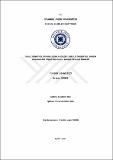Please use this identifier to cite or link to this item:
http://hdl.handle.net/11547/2191Full metadata record
| DC Field | Value | Language |
|---|---|---|
| dc.contributor.author | Güneş, İbrahim | - |
| dc.date.accessioned | 2019-05-26T10:26:09Z | - |
| dc.date.available | 2019-05-26T10:26:09Z | - |
| dc.date.issued | 2017 | - |
| dc.identifier.uri | http://hdl.handle.net/11547/2191 | - |
| dc.description.abstract | Bu araştırmanın konusu liderlik ile örgütsel sinizm arasındaki ilişkinin belirlenmesidir. Bunun için liderlik ile örgütsel sinizm arasındaki bağlantının belirlenen değişkenlere göre değişip değişmediği incelenmiştir. Araştırmanın evrenini İstanbul ili Bahçelievler İlçesi’nde görevli olan öğretmenlerden oluşturmaktadır. Araştırma örneklemini ise, İstanbul ili Bahçelievler İlçesi’nde Milli Eğitim Bakanlığı’na bağlı okullarda görev yapan öğretmenler içinden rastgele seçilenler oluşturmaktadır. Araştırmada, İstanbul Bahçelievler’deki sınıf ve branş öğretmenlerinin liderlik biçimleri ve örgütsel sinizm tutumları arasındaki ilişkiyi incelemek amacıyla ilişkisel tarama modeli kullanılmıştır. Araştırmada veri toplamak amacıyla, 3 kısımdan oluşan bir anket uygulanmıştır. Anketin ilk kısmı demografik bilgileri içermektedir. İkinci anket Bolman ve Deal (1991) tarafından geliştirilen 32 madde olan Liderlik Stilleri Belirleme Anketidir. Anketin üçüncü kısmında Brandes, Dharwadkar ve Dean (1999)’in bilişsel, duyuşsal, davranışsal faktörleri içeren örgütsel sinizm düzeyini ölçmek amacıyla kavramsallaştırdığı 14 maddelik ölçek kullanılmıştır. Veriler toplandıktan sonra; katılımcıların mesleki kıdem yaş, unvan ve cinsiyet gibi çeşitli değişkenlerin değerlendirmesi amacıyla bulgular incelenmiştir. Veriler parametrik olmadıkları için Mann-Whitney U testi ve Kruskal Wallis testi kullanılmıştır. Ayrıca veriler arası ilişkinin belirlenmesi amacıyla Spearman korelasyon testi uygulanmıştır. Yapılan araştırma sonunda liderlik ölçeği ve alt boyutlarında genel olarak mesleki kıdem ve çalışılan kurum değişkenleri arasında anlamlı farka rastlanmıştır. 11 yıl ve üstü kıdem yılına sahip olanların liderlik algısının daha yüksek olduğu sonucuna varılmıştır. Ayrıca çalışılan kurum değişkeni incelendiğinde ilkokul ve liselerde görev yapanların liderlik algısının ortaokullarda görev yapanlardan daha yüksek olduğu görülmüştür. Liderlik ve sinizm arasında ters yönlü ve orta düzeyde bir ilişkinin var olduğu sonucuna ulaşılmıştır. | tr_TR |
| dc.language.iso | tr | tr_TR |
| dc.publisher | İSTANBUL AYDIN ÜNİVERSİTESİ SOSYAL BİLİMLER ENSTİTÜSÜ | tr_TR |
| dc.subject | Liderlik | tr_TR |
| dc.subject | Sinizm | tr_TR |
| dc.subject | Eğitim | tr_TR |
| dc.subject | Okul | tr_TR |
| dc.subject | Öğretmen | tr_TR |
| dc.subject | Leadership | tr_TR |
| dc.subject | Cynicism | tr_TR |
| dc.subject | Education | tr_TR |
| dc.subject | School | tr_TR |
| dc.subject | Teacher | tr_TR |
| dc.title | OKUL YÖNETİCİLERİNİN LİDERLİK DÜZEYLERİ İLE ÖRGÜTSEL SİNİZM ARASINDAKİ İLİŞKİ: İSTANBUL BAHÇELİEVLER ÖRNEĞİ | tr_TR |
| dc.type | Thesis | tr_TR |
| dc.description.abstractol | The aim of this research is to determine the relation between leadership and organizational cynicism. For this, whether the relation between leadership and organizational cynicism changes or not according to determined factors has been studied. The topic of the research consists of the teachers working in Bahçelievler in the province of İstanbul.The sample of the research is the ones chosen at random among the teachers working at schools of the ministry of education in Bahçelievler in the province of İstanbul. In the research, relational scanning model has been used in order to study the relation between the attitudes of organizational cynicism and forms of leadership of the class and branch teachers in İstanbul. In the research in order to gather data, a survey consisting of 3 parts has been carried out. The first survey includes demographic information. The second survey is the survey of the description of leadership forms which contain 32 items and was developed by Bolman and Deal (1991). In the third part of the survey, a scale of 14 items was used which has been conceptualized by Brandes, Dharwodker and Dean in order to measure the level of organizational cynicism which contains cognitive, emotional and behavioral factors. After the data was gathered, findings have been studied so as to evaluate the various factors such as attendants’ vocational seniority, age, title and gender. As the data is not parametric, Mann Whitney U test and Kruskal Wallis test have been used. In addition, Spearman correlation test has been used so as to determine the relations between the data. At the end of the research, in the leadership scale and in its under dimensions, in general, a meaningful difference has been found between the workplace factors and vocational seniority. It has been found that the ones who have 11 or more years of vocational experience have a higher leadership perception. Moreover, when the workplace factor has been studied, the ones who work at primary school or highschool have a higher leadership perception than the ones working at secondary school. It has shown that there is a medium and opposite directional relation between cynicism and leadership. | tr_TR |
| dc.publisher.firstpagenumber | 1 | tr_TR |
| dc.publisher.lastpagenumber | 108 | tr_TR |
| Appears in Collections: | Tezler -- Thesis | |
Files in This Item:
| File | Description | Size | Format | |
|---|---|---|---|---|
| 473462.pdf | 3.13 MB | Adobe PDF |  View/Open |
Items in DSpace are protected by copyright, with all rights reserved, unless otherwise indicated.
